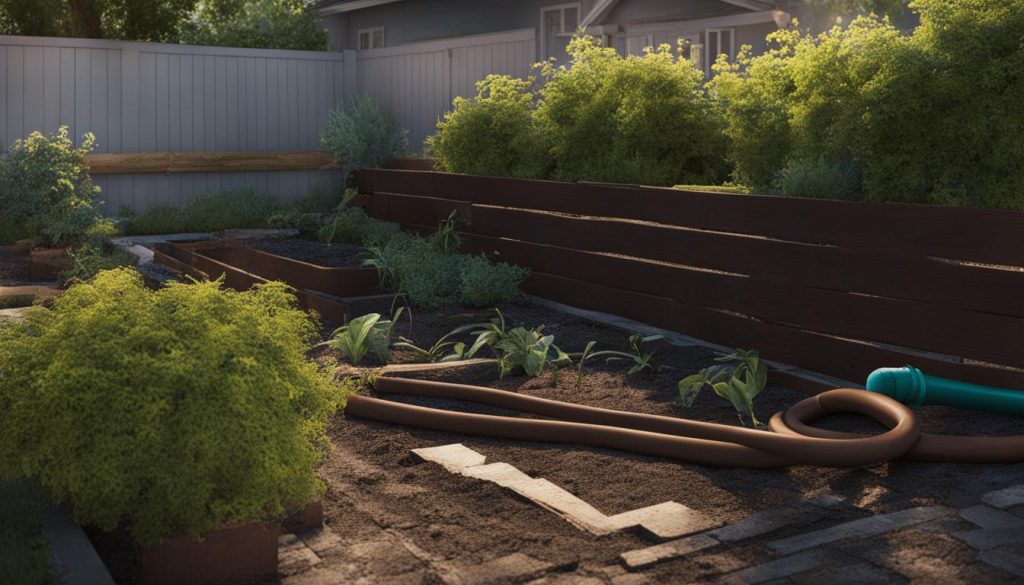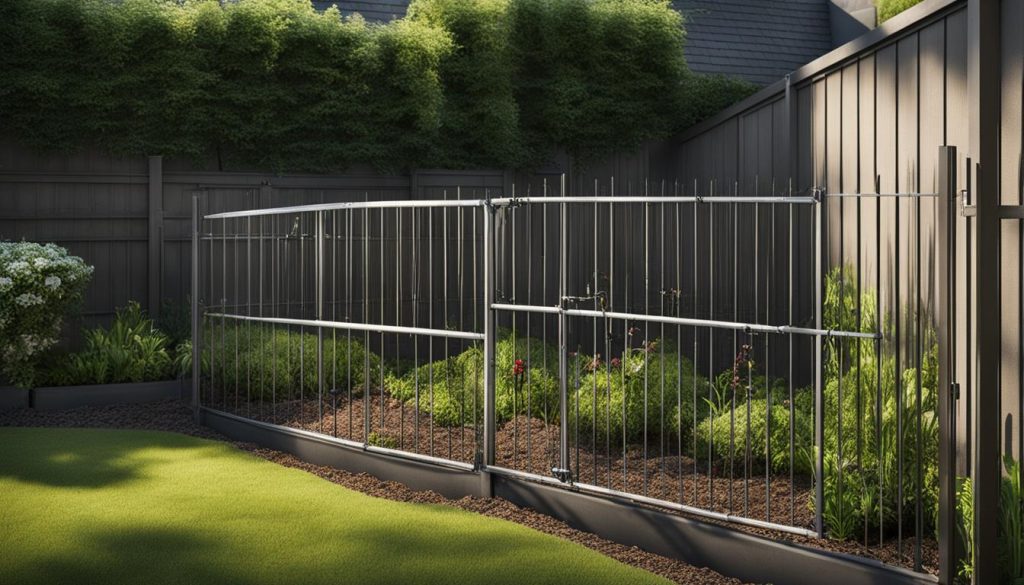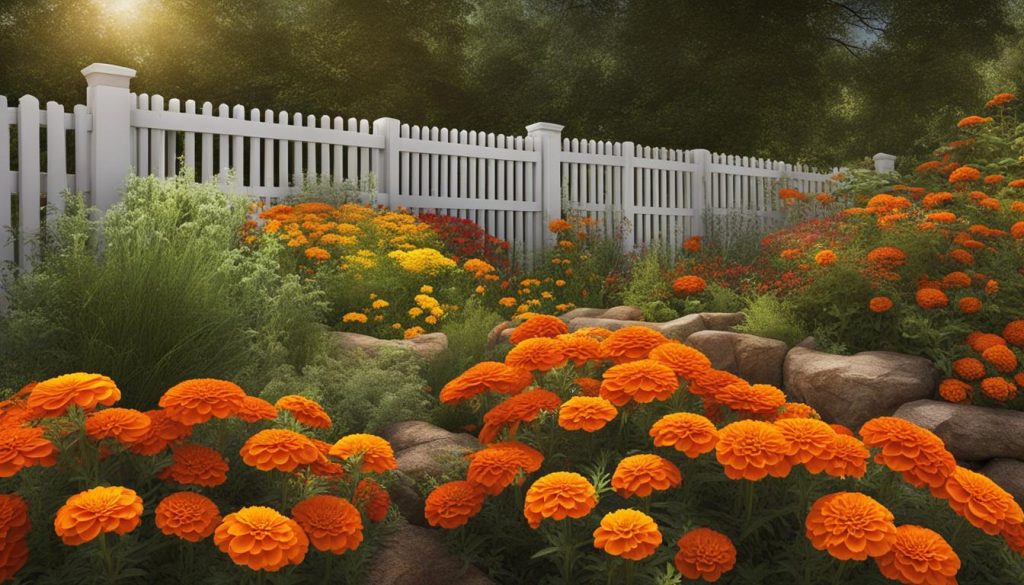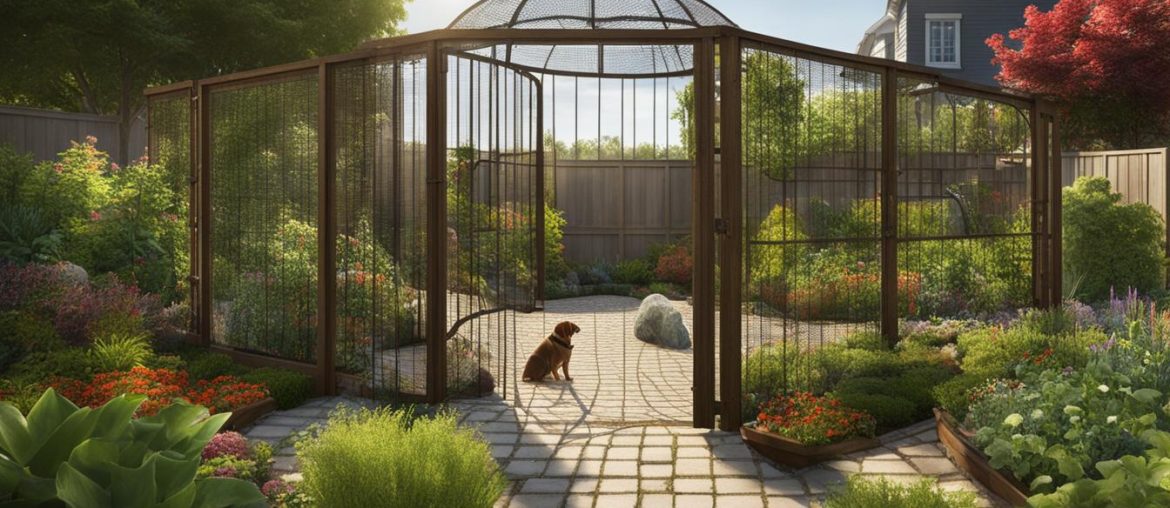Dogs can cause significant damage to gardens, from digging holes to urinating on plants and chewing on foliage. As a professional horticulturist, I understand the importance of keeping dogs out of the garden to protect the plants and maintain the beauty of the space. In this expert guide, I will share various strategies and techniques to help you deter dogs from entering your garden.
Whether you’re searching for dog repellent for gardens, dog-proof garden ideas, or dog-friendly garden solutions, you’ve come to the right place. I will provide you with practical tips and insights that will enable you to create a garden that is off-limits to dogs, ensuring the safety of your plants and the overall enjoyment of your outdoor space.
Key Takeaways:
- Implement physical deterrents such as bamboo stakes, chicken wire, or motion-activated sprinklers to keep dogs out of the garden.
- Utilize plant deterrents like marigolds and herbs with strong smells to discourage dogs from entering the garden.
- Experiment with natural scents such as vinegar-soaked rags, citrus spray, coyote urine, coffee grounds, and pepper to repel dogs.
- Train dogs to stay out of the garden by redirecting them to a designated play area and reinforcing good behavior.
- Create alternative paths for dogs and provide designated digging areas to redirect their energy away from the garden.
Reasons to Keep Dogs Out of Your Yard

Keeping dogs out of your yard is essential for several reasons. Firstly, dogs can cause significant damage to your yard and property. They have a natural instinct to dig, which can result in unsightly holes in your lawn and flower beds. Additionally, dogs may chew on furniture, garden art, or other outdoor items, leading to costly repairs or replacements. The constant presence of dogs in your yard can also negatively impact the overall aesthetic, making it difficult to maintain a beautiful outdoor space.
Furthermore, there are safety issues associated with dogs in yards. Some dogs may exhibit aggressive behavior, posing a threat to you, your family, and your neighbors. Additionally, dogs can carry diseases, such as fleas and ticks, which can be transmitted to humans or other animals. Moreover, the presence of dogs running around in your yard can create a tripping hazard, especially for young children or elderly individuals.
In order to maintain the integrity of your yard and ensure the safety of yourself and others, it is crucial to implement strategies to keep dogs out of your yard. By doing so, you can protect your property, enjoy a beautiful outdoor space, and promote a safe environment for everyone.
| Reasons to Keep Dogs Out of Your Yard |
|---|
| Dogs can cause damage to property, such as digging holes and chewing on furniture or garden art. |
| Dogs may exhibit aggressive behavior, posing a safety threat. |
| Dogs can carry diseases and create a tripping hazard. |
Physical Deterrents for Keeping Dogs Out of the Garden

Dogs can be deterred from entering the garden by using various physical deterrents. These strategies help create barriers that make it difficult for dogs to access and damage plants. Some effective physical deterrents include:
- Bamboo stakes: Planting bamboo stakes around the garden can act as a barrier, preventing dogs from easily navigating through the plants.
- Chicken wire: Laying chicken wire over the soil between plants can deter dogs from digging and entering the garden.
- Cover crops: Planting cover crops like sedum can make the soil harder to access and discourage dogs from digging.
- Motion-activated sprinklers: Installing motion-activated sprinklers can startle dogs and discourage them from entering the garden.
- Fences or hedges: Erecting fences or hedges around the garden area can provide a physical barrier that prevents dogs from entering.
These physical deterrents can help protect the garden from damage caused by dogs and maintain the beauty of the space.
Table: Comparison of Physical Deterrents for Keeping Dogs Out of the Garden
| Deterrent | Effectiveness | Pros | Cons |
|---|---|---|---|
| Bamboo stakes | ✓ | Cost-effective | May require regular maintenance |
| Chicken wire | ✓✓ | Easy to install | May not be aesthetically pleasing |
| Cover crops | ✓✓✓ | Natural deterrent | Requires time to establish |
| Motion-activated sprinklers | ✓✓✓✓ | Effective in deterring dogs | Might startle other animals or people |
| Fences or hedges | ✓✓✓✓✓ | Provides a strong physical barrier | Can be expensive and require professional installation |
Table: Comparison of different physical deterrents for keeping dogs out of the garden. Evaluates their effectiveness, pros, and cons. ✓ indicates low, ✓✓✓✓✓ indicates high.
Plant Deterrents for Keeping Dogs Out of the Garden

When it comes to keeping dogs out of the garden, certain plants can serve as effective deterrents. The strong scents and tastes of these plants are often disliked by dogs, making them less likely to enter the garden. Two popular options for plant deterrents are marigolds and herbs.
Marigolds
Marigolds are not only beautiful flowers that add vibrant colors to the garden, but they also emit a pungent odor that dogs find unpleasant. Planting marigolds around the perimeter of the garden or interspersing them throughout can help keep dogs at bay. Choose varieties such as French marigolds (Tagetes patula) or African marigolds (Tagetes erecta) for maximum effectiveness. These flowers are easy to grow and maintain, making them a convenient option for dog-proofing your garden.
Herbs
In addition to marigolds, certain herbs can also act as natural deterrents for dogs. Herbs like rosemary, lavender, lemongrass, and lemon thyme have strong and distinct smells that can repel dogs. Planting these herbs in and around the garden can help create a barrier that dogs are less likely to cross. Their aromatic scents not only keep dogs away but also add a pleasant fragrance to the garden.
To maximize the deterrent effect, consider planting marigolds and herbs in strategic locations throughout the garden, paying particular attention to the areas where dogs are most likely to enter or linger. These plant deterrents can be an environmentally friendly and aesthetically pleasing way to keep dogs out of your garden.
| Plant | Deterrent Effect |
|---|---|
| Marigolds | Pungent odor disliked by dogs |
| Rosemary | Strong scent repels dogs |
| Lavender | Distinct smell deters dogs |
| Lemongrass | Repels dogs with its fragrance |
| Lemon Thyme | Strong scent keeps dogs away |
“Planting marigolds and herbs in your garden can serve as natural deterrents for dogs. These plants emit strong scents and tastes that dogs find unpleasant, making them less likely to enter the garden. Plus, they add beauty and fragrance to your outdoor space.”
Natural Scents to Deter Dogs from the Garden

When it comes to keeping dogs out of the garden, natural scents can be a powerful tool. These scents can help deter dogs from entering the garden area and protect your plants. Let’s explore some of the most effective natural scents:
Vinegar-soaked Rags
Vinegar-soaked rags can be tied around the garden to repel dogs. The strong smell of vinegar is often unpleasant to dogs and can help keep them at bay. Simply soak some rags in vinegar and tie them to stakes or other garden structures near the perimeter of your garden. This can create a barrier that dogs are less likely to cross.
Citrus Spray
Citrus spray made from lemon juice and water is another effective natural scent to deter dogs. Dogs have a strong aversion to the smell of citrus fruits. You can create a DIY citrus spray by mixing equal parts lemon juice and water in a spray bottle. Then, generously spray the perimeter of your garden to create a scent barrier that dogs will find unappealing.
“Vinegar-soaked rags and citrus spray are natural and effective ways to repel dogs from the garden. These scents are unpleasant to dogs and can help keep them away from your plants.”
Coyote Urine
Coyote urine may sound unusual, but it can be an effective deterrent for dogs. Coyotes are natural predators to dogs, and the scent of their urine can signal danger. You can find coyote urine products online or in hardware stores. Simply splash the urine around the perimeter of your yard to create a scent barrier that dogs will want to avoid.
Coffee Grounds and Pepper
Coffee grounds and pepper are additional natural scents that can deter dogs from entering the garden. Sprinkling coffee grounds and pepper around the garden can create a scent barrier that dogs find unpleasant. These scents can be especially effective if you notice that dogs are attracted to specific areas of your garden.
By utilizing natural scents like vinegar-soaked rags, citrus spray, coyote urine, coffee grounds, and pepper, you can help keep dogs out of your garden. These methods are safe, eco-friendly, and can be easily implemented to protect your plants.
Training Dogs to Stay Out of the Garden

Training dogs to stay out of the garden is an effective long-term solution for keeping your plants safe and maintaining the beauty of your outdoor space. By redirecting dogs and using temporary barriers, you can teach them to avoid the garden area.
When a dog approaches the garden, offer a firm “No” command to let them know that the area is off-limits. Redirect their attention to a preferred play area, such as a designated spot with toys or activities. Providing positive reinforcement when they follow your redirection will help reinforce the desired behavior.
Temporary barriers can also be used to aid in training. Fences or gates can be installed to physically block access to the garden. Temporary netting or mesh can be attached to existing structures or surrounding trees to create a barrier. These barriers should be secure and tall enough to prevent dogs from jumping over or squeezing through.
Consistency is key when training dogs to stay out of the garden. Continually reinforce the rules and redirect their behavior as needed. With time and patience, you can train your dogs to respect the boundaries of your garden and enjoy a harmonious outdoor space.
Tips for Training Dogs to Stay Out of the Garden:
- Be consistent with commands and redirecting behavior
- Provide positive reinforcement for desired behavior
- Use temporary barriers like fences or netting
- Create a designated play area for dogs
- Consider professional dog training for challenging cases
Remember that training dogs requires patience and dedication. Be consistent in your efforts and provide a safe and engaging environment for your furry friends. With the right approach, you can have a beautiful garden that coexists peacefully with your beloved pets.
| Training Method | Pros | Cons |
|---|---|---|
| Redirecting Behavior | – Teaches dogs to avoid the garden – Reinforces positive behavior – Can be done without physical barriers |
– Requires consistent effort – May take time for dogs to learn – Some dogs may require additional training methods |
| Temporary Barriers | – Physically blocks access to the garden – Provides immediate deterrence – Can be easily removed when training is complete |
– May disrupt the overall aesthetic of the garden – Requires careful installation to ensure effectiveness – Dogs may try to circumvent or escape barriers |
| Professional Dog Training | – Expert guidance and support – Tailored approach to individual dogs – Can address complex behavioral issues |
– Requires additional cost – Time commitment for training sessions – May not be necessary for all dogs |
Creating Alternative Paths to Prevent Dogs from Running Into the Garden
Dogs love to explore their surroundings, and sometimes that includes venturing into our precious gardens. To prevent dogs from running into the garden and potentially causing damage, it’s important to create alternative paths that divert their attention away from the plants. By using soft materials and rockier textures, we can create pathways that are more appealing for dogs to follow.
Soft Materials:
One effective way to create alternative paths for dogs in the garden is by using soft materials such as dog-safe mulch or AstroTurf. These materials provide a comfortable surface for dogs to walk on, making them less likely to venture into the garden where the soil may be uneven or muddy. By laying down a layer of mulch or AstroTurf along designated pathways, you can steer the dogs away from the delicate plants and towards a more suitable area.
Rockier Textures:
On the other hand, if you prefer a more natural look for your garden, you can create rockier textures using pebbles or other substrate. Dogs generally dislike walking on rough or rocky surfaces, so incorporating these textures around the plants can discourage them from stepping on them. Placing larger rocks strategically along the garden edges can also act as a visual barrier, signaling to dogs that they should stay on the designated paths instead.
Creating alternative paths not only prevents dogs from running into the garden but also provides them with a designated area to explore. By offering an appealing and safe route, you can ensure that your garden remains free from unwanted doggy footprints and your plants stay protected.
| Advantages | Disadvantages |
|---|---|
| Provides a designated area for dogs to explore | Requires regular maintenance to keep the pathways clean and intact |
| Diverts dogs’ attention away from the delicate plants | May require additional space and planning in the garden layout |
| Can be customized to match the overall garden design | May not be effective for all dogs, as some may still be tempted to venture into the garden |
Designated Digging Areas for Dogs

If you have a dog that loves to dig, providing them with a designated digging area can be a great solution. By redirecting their digging instincts towards a specific spot, you can protect your garden while still allowing your furry friend to indulge in their natural behavior. A sandbox for dogs is a popular choice for creating a designated digging area.
A sandbox for dogs is essentially a small area filled with sand or loose dirt where your dog can dig to their heart’s content. You can either purchase a premade sandbox specifically designed for dogs or create a DIY version using a sturdy container filled with sand. To encourage your dog to use the designated area, you can bury some toys or treats in the sand to make it more enticing.
Redirecting Dogs to the Designated Digging Area
When introducing the designated digging area to your dog, it’s important to redirect their attention to the designated area whenever they start digging elsewhere. When you catch your dog digging in the garden or another unauthorized area, calmly say “No” and guide them to the sandbox. Once they start digging in the designated area, reward them with praise, treats, or playtime to reinforce the behavior.
Consistency is key when training your dog to use the designated digging area. Be patient and persistent, and over time, your dog will learn to associate the sandbox with their digging needs. This will not only protect your garden but also provide your dog with an outlet for their natural instincts and help prevent frustration or boredom.
| Pros | Cons |
|---|---|
|
|
Using Signs and Video Cameras as Deterrents
When it comes to keeping dogs out of your garden, using signs and video cameras can be effective deterrents. By strategically placing signs around the perimeter of your garden, you can inform dog owners that the area is off-limits. The signs can be simple and straightforward, stating “No Dogs Allowed” or “Private Garden.” Pairing visible barriers, such as fences or hedges, with these signs can make it easier for neighbors and passersby to see and understand the boundaries.
In addition to signs, video cameras can serve as a powerful tool for deterrence. By installing cameras in key locations around your garden, you can capture evidence of dogs and their owners trespassing in the area. This can be particularly useful if you need to involve authorities or homeowners associations to address the issue. It also provides a visual record that can help identify repeat offenders and ensure accountability.
Identifying trespassing dogs can be challenging, but video footage can provide valuable evidence. By documenting the incidents, you can help identify the owners responsible for allowing their dogs to roam freely in your garden. This information can be used to address the issue directly with the owners or involve appropriate authorities if necessary.
| Pros | Cons |
|---|---|
| Clear indication that the garden is off-limits | May not deter determined dogs |
| Visible reminder for dog owners to keep their pets away | Requires regular maintenance and replacement of signs |
| Recorded evidence of trespassing dogs and their owners | Can be an additional expense to install and maintain video cameras |
Using Chicken Wire as a Temporary Aid
When it comes to keeping dogs out of the garden, using chicken wire can be a practical and effective temporary solution. Chicken wire can be easily laid over plants to create a protective barrier, keeping dogs from accessing and damaging them. This versatile material is commonly used for fencing and is readily available at hardware stores.
To protect your plants with chicken wire, simply measure the area you want to cover and cut the chicken wire to fit. Ensure the wire is tightly secured to prevent dogs from getting underneath. It’s important to trim any sharp edges to avoid accidental injuries to the dogs. Chicken wire is a flexible option that can be easily removed or repositioned as needed, making it a convenient solution for temporary garden protection.
Pre-made Chicken Wire Enclosures
If you’re looking for a more permanent and hassle-free solution, pre-made chicken wire enclosures are an excellent option. These enclosures are specifically designed to protect plants from dogs, ensuring both the safety of your garden and your furry friends. They come in various sizes and shapes, allowing you to choose the one that best suits your garden layout.
Pre-made chicken wire enclosures provide a sturdy and durable barrier, preventing dogs from accessing and damaging your beloved plants. They are easy to assemble and require minimal maintenance. With their robust construction, these enclosures offer reliable protection for your garden year-round, giving you peace of mind.
Table: Pros and Cons of Using Chicken Wire
| Pros | Cons |
|---|---|
| Easy to use and install | May not be aesthetically pleasing |
| Effective in keeping dogs out | Requires regular maintenance |
| Flexible and adjustable | Can be challenging to cut and shape |
| Affordable and readily available | May not provide complete protection from small dogs or determined diggers |
As with any garden protection method, using chicken wire has its pros and cons. While it is an affordable and effective solution, it may not be the most visually appealing option. Regular maintenance is also necessary to ensure its efficiency. However, the flexibility and adjustability of chicken wire make it a popular choice among gardeners seeking a temporary aid to keep dogs out.
Wrapping Up
In conclusion, keeping dogs out of the garden is essential to protect the plants and maintain the aesthetic appeal of your outdoor space. By implementing a combination of strategies and techniques, you can create a dog-free environment that is safe and enjoyable for both you and your furry friends.
Physical deterrents such as bamboo stakes, chicken wire, motion-activated sprinklers, and fences or hedges can effectively prevent dogs from entering the garden. Planting natural deterrents like marigolds and herbs can also help keep dogs at bay with their unpleasant odors. Additionally, using natural scents such as vinegar-soaked rags, citrus spray, coyote urine, coffee grounds, and pepper can further discourage dogs from venturing into the garden.
Training dogs to stay out of the garden through redirection and the use of temporary barriers is a long-term solution that can yield positive results. Creating alternative paths and designated digging areas can redirect their energy away from your precious plants. Furthermore, utilizing signs and video cameras as deterrents can serve as a visual reminder for dog owners to respect the boundaries of your garden.
Ultimately, by employing these strategies, you can create a harmonious environment where your garden thrives and your furry friends can enjoy their outdoor space without causing any damage. Remember, the importance of keeping dogs out of the garden lies in preserving the beauty of your landscape and ensuring the well-being of both your plants and your pets.
FAQ
How can I keep dogs out of my garden?
There are several strategies you can use to deter dogs from entering your garden, including physical deterrents, plant deterrents, natural scents, training, creating alternative paths, providing designated digging areas, using signs and video cameras, and using chicken wire as a temporary aid.
What are some physical deterrents for keeping dogs out of the garden?
Physical deterrents include planting bamboo stakes to form a barrier, laying chicken wire over the soil to deter digging, using cover crops like sedum to make the soil hard to access, installing motion-activated sprinklers to startle dogs, and using fences or hedges to enclose the garden.
Can certain plants deter dogs from entering the garden?
Yes, marigolds and herbs like rosemary, lavender, lemongrass, and lemon thyme have strong smells that dogs find unpleasant. Planting these around the garden can help keep dogs away.
What natural scents can be used to deter dogs from the garden?
Vinegar-soaked rags, citrus spray made from lemon juice and water, coyote urine, coffee grounds, and pepper can all be used as natural scents to deter dogs from entering the garden.
How can I train my dog to stay out of the garden?
By offering a stern “No” when the dog approaches the garden and redirecting them to a preferred play area, they can learn to avoid the garden area. Temporary barriers, such as fences, can also be used to reinforce the training.
What can I do to create alternative paths to prevent dogs from running into the garden?
Using soft materials like dog-safe mulch or AstroTurf to create a path can be inviting for the dogs. Creating a rockier texture with pebbles or other substrate around the plants can discourage dogs from stepping on them.
How can I provide a designated digging area for my dog?
You can purchase a pre-made sandbox or create one yourself. By redirecting the dog to the designated digging area and providing positive reinforcement, they can be trained to use it instead of the garden.
Can signs and video cameras be used to deter dogs from the garden?
Yes, signs can inform dog owners that the garden is off-limits, and pairing a visible barrier, such as a fence, with the sign can make it easier for neighbors to see and understand the boundaries. Video cameras can help identify dogs and their owners who may be trespassing in the garden, which can be useful for contacting authorities or homeowners associations if necessary.
How can I use chicken wire as a temporary aid to protect my plants?
Chicken wire can be laid over the plants to create a barrier. Just make sure there are no sharp edges exposed to avoid accidentally injuring dogs. Premade chicken wire enclosures can also be used to protect plants and save time.






